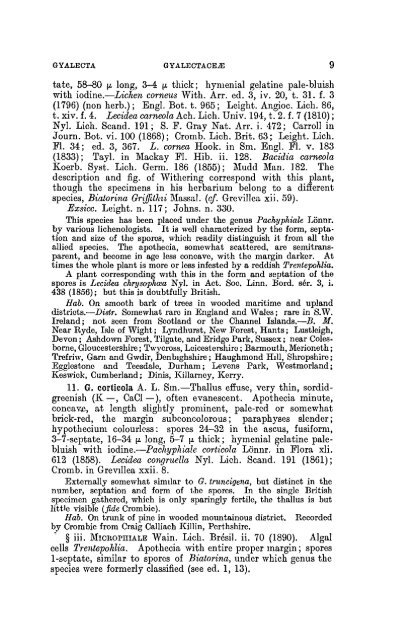BRITISH LICHENS
BRITISH LICHENS
BRITISH LICHENS
Create successful ePaper yourself
Turn your PDF publications into a flip-book with our unique Google optimized e-Paper software.
GYALECTA GYALECTACElE 9<br />
tate, 58-80 (.L long, 3-4 (.L thick; hymenial gelatine pale-bluish<br />
with iodine.-Lichen corneus With. Arr. ed. 3, iv. 20, t. 31. f. 3<br />
(1796) (non herb.); Eng!. Bot. t. 965; Leight. Angioc. Lich. 86,<br />
t. xiv. f. 4. Lecidea carneola Ach. Lich. Univ. 194, t. 2. f. 7 (1810);<br />
Ny!. Lich. Scand. 191; S. F. Gray Nat. Arr. i. 472; Carroll in<br />
Journ. Bot. vi. 100 (1868); Cromb. Lich. Brit. 63; Leight. Lich.<br />
F!. 34; ed. 3, 367. L. cornea Hook. in Sm. Eng!. F!. v. 183<br />
(1833); Tayl. in Mackay Fl. Hib. ii. 128. Bacidia carneola<br />
Koerb. Syst. Lich. Germ. 186 (1855); Mudd Man. ] 82. The<br />
description and fig. of Withering correspond with this plant,<br />
though the specimens in his herbarium belong to a different<br />
species, Biatorina Griffitlni Massa!. (cf. Grevillea xii. 59).<br />
Exsicc. J.Jeight. n. 117 ; Johns. n. 330.<br />
This species has been placed under the genus Pachyphiale Lonnr.<br />
by various lichenologists. It is well characterized by the form, septa·<br />
tion and size of the spores, which readily distinguish it from all the<br />
allied species. The apothecia, somewhat scattered. are semitransparent,<br />
and become in age less concave, with the margin darker. At<br />
times the whole plant is more or less infested by a reddish Trentepohlia.<br />
A plant corresponding WIth this in the form and septation of the<br />
spores is Lecidea chrysophrxa Ny!. in Act. Soc. Linn. Bord. ser. 3, i.<br />
438 (1856); but this is doubtfully British.<br />
Hab. On smooth bark of trees in wooded maritime and upland<br />
districts.-Distr. Somewhat rare in England and Wales; rare in S.W.<br />
Ireland; not seen from Scotland or the Channel Islands.-B. M.<br />
Near Ryde, Isle of Wight; Lyndhurst, New Forest, Hants; Lustleigh,<br />
Devon; Ashdown Forest, Tilgate, and Eridgo Park, Sussex; near Colesborne,<br />
Gloucestershire; Twycross, Leicestershire; Barmouth, lVferioneth;<br />
Trefriw, Gam and Gwdir, DenbIghshire; Haughmond HIll, Shropshire;<br />
Egglestono and Teesdale, Durham; Levens Park, Westmorland;<br />
Keswick, Cumberland; Dinis, Killarney, Kerry.<br />
11. G. corticola A. L. Sm.-Thallus effuse, very thin, sordidgreenish<br />
(K -, CaCI -), often evanescent. Apothecia minute,<br />
concav.e, at length slightly prominent, pale-red or somewhat<br />
brick-red, the margin subconcolorous; paraphyses slender;<br />
hypothecium colourless: spores 24-32 in the ascus, fusiform,<br />
3-7-septate, 16-34 (.L long, 5-7 (.L thick; hymenial gelatine palebluish<br />
with iodine.-Pachyphiale corticola Lonnr. in Flora xli.<br />
612 (1858). Lecidea congruella Nyl. Lich. Scand. 191 (1861);<br />
Cromb. in Grevlllea xxii. 8.<br />
Externally somewhat similar to G. truncigena, but distinct in the<br />
number, septation and form of the spores. In the single British<br />
specimen gathered, which is only sparingly fertile, the thallus is but<br />
little visible (fide Crombie).<br />
Hab. On trunk of pine in wooded mountainous district. Recorded<br />
by Crombie from Craig Calliach Killin, Perthshire.<br />
o § iii. MICROPIIIALE Wain. Lich. Bresil. ii. 70 (1890). Algal<br />
cells Trentepohlia. Apothecia with entire proper margin; spores<br />
I-septate, similar to spores of Biatorina, under which genus the<br />
species were formerly classified (see ed. I, 13).

















